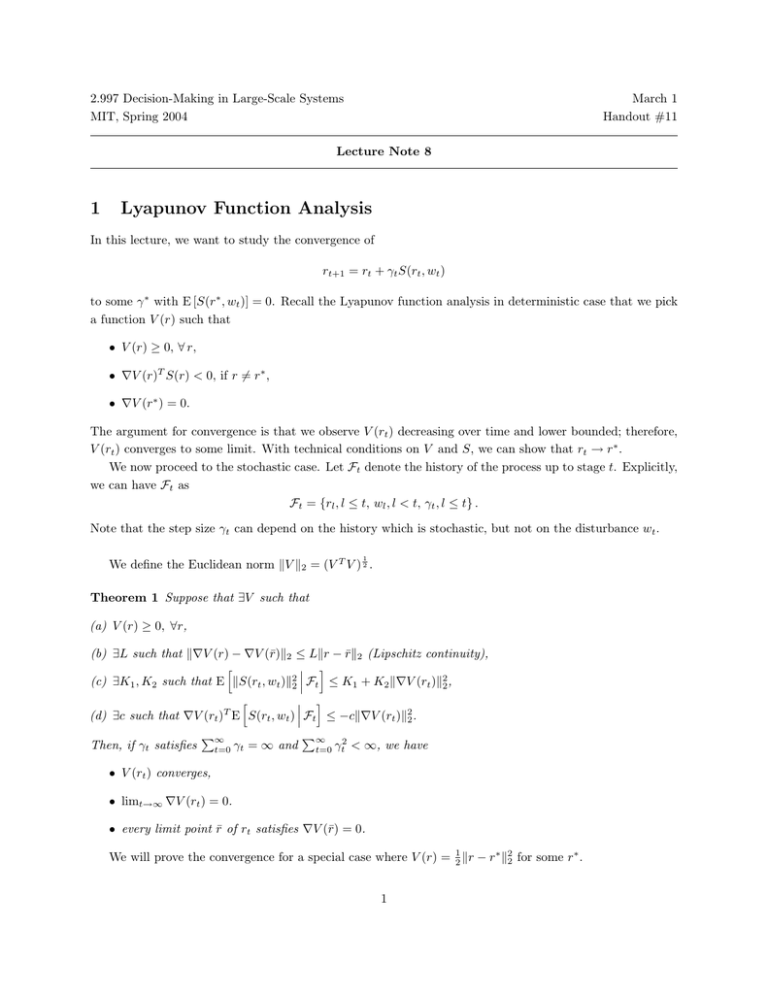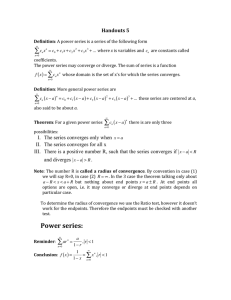1 Lyapunov Function Analysis
advertisement

2.997 Decision­Making in Large­Scale Systems
MIT, Spring 2004
March 1
Handout #11
Lecture Note 8
1
Lyapunov Function Analysis
In this lecture, we want to study the convergence of
rt+1 = rt + γt S(rt , wt )
to some γ ∗ with E [S(r∗ , wt )] = 0. Recall the Lyapunov function analysis in deterministic case that we pick
a function V (r) such that
• V (r) ≥ 0, ∀ r,
• �V (r)T S(r) < 0, if r �= r∗ ,
• �V (r∗ ) = 0.
The argument for convergence is that we observe V (rt ) decreasing over time and lower bounded; therefore,
V (rt ) converges to some limit. With technical conditions on V and S, we can show that rt → r∗ .
We now proceed to the stochastic case. Let Ft denote the history of the process up to stage t. Explicitly,
we can have Ft as
Ft = {rl , l ≤ t, wl , l < t, γt , l ≤ t} .
Note that the step size γt can depend on the history which is stochastic, but not on the disturbance wt .
1
We define the Euclidean norm �V �2 = (V T V ) 2 .
Theorem 1 Suppose that ∃V such that
(a) V (r) ≥ 0, ∀r,
(b) ∃L such that ��V (r) − �V (r̄)�2 ≤ L�r − r̄�2 (Lipschitz continuity),
� �
�
�
(c) ∃K1 , K2 such that E �S(rt , wt )�22 � Ft ≤ K1 + K2 ��V (rt )�22 ,
� �
�
�
(d) ∃c such that �V (rt )T E S(rt , wt ) � Ft ≤ −c��V (rt )�22 .
Then, if γt satisfies
�∞
t=0
γt = ∞ and
�∞
t=0
γt2 < ∞, we have
• V (rt ) converges,
• limt→∞ �V (rt ) = 0.
• every limit point r̄ of rt satisfies �V (r̄) = 0.
We will prove the convergence for a special case where V (r) = 12 �r − r∗ �22 for some r∗ .
1
Theorem 2 Suppose V (r) = 12 �r − r∗ �22 satisfies
� �
�
�
(a) ∃K1 , K2 such that E �S(rt , wt )�22 � Ft ≤ K1 + K2 V (rt ),
� �
�
�
(b) ∃c such that �V (rt )T E S(rt , wt ) � Ft ≤ −cV (rt ).
Then, if γt > 0 with
�∞
t=0
γt = ∞ and
�∞
t=0
γt2 < ∞,
rt → r ∗ ,
w.p. 1.
We use the following Supermartingale convergence theorem to prove Theorem 2.
Theorem 3 (Supermartingale Convergence Theorem) Suppose that Xt , Yt and Zt are nonnegative
�∞
random variables and t=1 Yt < ∞ with probability 1. Suppose also that
� �
�
�
E Xt+1 �Ft ≤ Xt + Yt − Zt ,
w.p. 1.
Then
1. Xt converges to a limit with probability 1,
�∞
2.
t=1 Zt < ∞.
The key idea for the proof of Theorem 2 is to show that V (rt ) is a supermartingale, so that V (rt ) converges
and then show that it converges to zero w.p. 1.
Proof: [Theorem 2]
�
� �
� �
�
1
�
�
E V (rt+1 )�Ft
= E �rt+1 − r∗ �22 �Ft
2
�
� �
1
�
= E (rt + γt St − r∗ )T (rt + γt St − r∗ )�Ft
(St � S(rt , wt ))
2
� �
� � � γ2 �
1
�
�
=
(rt − r∗ )T (rt − r∗ ) + γt (rt − r∗ )T E St �Ft + t E StT St �Ft
2
2
Since V (rt ) = 12 �rt − r∗ �22 , �V (rt ) = (rt − r∗ ). Then
� �
� �
�
� � � γ2 �
�
�
�
E V (rt+1 )�Ft
= V (rt ) + γt (rt − r∗ )T E St �Ft + t E �St �22 �Ft
2
� �
� � � γ2 �
�
�
= V (rt ) + γt �V (rt )T E St �Ft + t E �St �22 �Ft
2
γ2
≤ V (rt ) − γt cV (rt ) + t (K1 + K2 V (rt ))
2�
�
γt2 K2
γ2
≤ V (rt ) − γt c −
V (rt ) + t K1
� �� �
2
2
�
��
� � �� �
Xt
Zt
Since γt > 0 and
�∞
t=0
Yt
γt2 < ∞, γt must converge to zero, and Zt ≥ 0 for all large enough t. Moreover,
∞
�
t=0
Yt =
∞
K1 � 2
γ < ∞.
2 t=0 t
2
Therefore, by Supermartingale convergence theorem,
V (rt ) converges w. p. 1, and
�
∞ �
�
γt2 K2
V (rt ) < ∞, w. p. 1.
γt c −
2
t=0
�∞
�∞
Suppose that V (rt ) → � > 0. Then, by hypothesis that t=0 γt = ∞ and t=0 γt2 < ∞, we must have
�
∞ �
�
γ 2 K2
γt c − t
V (rt ) = ∞
2
t=0
which is a contradiction. Therefore
lim �rt − r∗ �22 = 0
w.p. 1 ⇒ rt → r∗ w.p. 1.
t→∞
2
Example 1 (Stochastic Gauss­Seidel) Consider1
rt+1 (it )
rt+1 (i)
= rt (it ) + γt ((F rt )(it ) − rt (it )) ,
= rt (it ), ∀ i �= it .
Suppose that F is a � · �2 contraction. Suppose also that it , t = 1, 2, . . . , are chosen i.i.d. with P (it = i) =
πi > 0. Then
rt+1 (i) = rt (i) + γt πi ((F rt )(i) − rt (i)) + γt [1(it = i) − πi ] [(F rt )(i) − rt (i)]
��
�
�
wt (i)
Define
⎡
π1
⎢
⎢ 0
Π=⎢
⎢
⎣ 0
0
0
π2
0
0
..
0
0
0
.
...
...
0
0
...
...
0
πn
⎤
⎥
⎥
⎥
⎥
⎦
then
rt+1 = rt + γt Π(F rt − rt ) +γt wt .
�
��
�
E[St |Ft ]
Let V (r) =
1
2 (r
∗ T
−1
−r ) Π
∗
(r − r ) ≥ 0. Then we have
�V (r) = Π−1 (r − r∗ )
(Lipschitz continuity holds).
We also have
� � �
�
�V (rt )T E St �Ft
= (rt − r∗ )T Π−1 Π(F rt − rt ) = (rt − r∗ )T (F rt − r∗ + r∗ − rt )
= −(rt − r∗ )T (rt − r∗ ) + (rt − r∗ )T (F rt − r∗ )
1 Recall
≤
−�rt − t∗ �22 + �rt − r∗ �2 �F rt − r∗ �2
≤
−�rt − t∗ �22 + α�rt − t∗ �22
≤
−(1 − α) min πi2 ��V (rt )�22 .
i
the AVI: rt+1 (it ) = (F rt )(it )
3
We finally have
�
�
�
�
E �St �22 |Ft = E (F rt )(it ) − rt (it ))2 |Ft
�
�
≤ E �F rt − rt �22 |Ft
= �F rt − rt �22
≤ �F rt − r∗ �22 + �rt − r∗ �22
≤ (1 + α)�rt − r∗ �22
≤ (1 + α) max πi2 ��V (rt )�22 .
i
We conclude by Theorem 1 that stochastic Gauss­Seidel converges.
2
Q­learning
Recall that the Q­learning algorithm updates the Q factor according to
Qt+1 (xt , at ) = Qt (xt , at ) + γt (gat (xt ) + α min
Qt (xt+1 , a� ) − Qt (xt , at )).
�
a
This update can be rewritten as
⎡
Qt+1 (x, a) = Qt (x, a)
⎤
⎢
⎥
⎢
⎥
�
⎢
⎥
�
−Q
(x,
a)
+ γt (x, a) ⎢ga (x) + α
Pa (x, y) min
Q
(y,
a
)
⎥
t
t
a�
⎢
⎥
y
⎣
⎦
�
��
�
(HQ)(x,a)
⎤
⎡
⎥
⎢
�
⎥
⎢
�
� ⎥
⎢
+ αγt (x, a) ⎢min
Q
(x
,
a
)
−
P
(x,
y)
min
Q
(y,
a
)
t
t+1
a
t
⎥
�
a�
⎦
⎣ a
y
�
��
�
wt
where
if (x, a) �= (xt , at )
γt (x, a) = 0,
γt (xt , at ) = γt
� �
�
�
E γt wt �Ft = 0
|wt | ≤ �Qt �∞ .
Then, we have
Qt+1 = Qt + γt (HQt − Qt ) + αγt wt .
We can use the following theorem to show that Q­learning converges, as long as every state and action
pair are visited infinitely many times.
�
�
Theorem 4 Let rt+1 (i) = rt (i) + γt (i) (Hrt )(i) − rt (i) + wt (i) . Then, if
� � �
�
• E wt �Ft = 0
4
� �
�
�
• E wt2 (i)�Ft ≤ A + B�rt �2 for some norm � · �
•
�∞
t=0
γt (i) = ∞,
�∞
t=0
γt (i)2 < ∞, ∀ i
• H is a maximum­norm contraction,
then rt → r∗ w.p. 1 (Hr∗ = r∗ ).
Comparing Theorems 2 and 4, note that, if H is a maximum­norm contraction, convergence occurs under
weaker conditions than if it is an Euclidean norm contraction.
Corollary 1 If
�∞
t=0
γt (x, a) = ∞ with probability 1 for all (x, a), we have
Qt → Q∗
3
w.p. 1.
ODE Approach
Often times, the behavior of rt+1 = rt + γt S(rt , wt ) may be understood by analyzing the following ODE
instead:
r˙t = E [S(rt , wt )] .
The main idea for the ODE approach is as follows. Look at intervals [tm , tm+1 ) such that
tm+1 −1
�
γt = γ,
where γ is small.
t=tm
Set rm ≡ rtm . Then
rt ≈ rtm + O(γ),
∀ t ∈ [tm , tm+1 ).
(1)
Then
tm+1 −1
rm+1
= rtm+1 = rm +
�
γt S(rt , wt )
t=tm
tm+1 −1
�
≈ rtm +
�
�
γt S(rt , wt ) + O(γ)
(2)
t=tm
tm+1 −1
= rtm + γ
� γt
S(rt , wt ) + O(γ 2 )
γ
t=t
m
∼
= rm + γE [S(rm , w)] + O(γ 2 )
Therefore we can think of the stochastic scheme as a discrete version of the ODE
rm+1 = rm + γE [S(rm , w)] ⇒ ṙ = E [S(r, w)] .
To make the argument rigorous, steps (1), (2) and (3) have to be justified.
5
(3)




